February 2025, Paris, France
Here is part 1 of the article on Rétromobile 2025, devoted to the main exhibitions, manufacturers, museums and clubs. Part 2 will be mainly dedicated to exceptional car dealers and auction houses.
Trends & feelings
Retromobile 2025 was a great popular success, with an absolute attendance record. 146,000 visitors (the previous record was set in 2019 with 132,000 visitors) were welcomed by 620 exhibitors (up 20% on 2024) over an area of more than 80,000 m². Saturday February 8 was another historic day, with 37,000 people visiting the show. Once again, manufacturers, dealers, accessory manufacturers, publishers, artists, museums, clubs and associations offered visitors an exceptional line-up, covering the entire automobile history.



Before looking back at this year’s show in more details and in pictures, here are a few feelings and trends, all of which are necessarily subjective. First confirmation: more and more carmakers are exhibiting, drawing on their heritage around brand or model anniversaries to promote their current models. The gap is sometimes wide when these modern cars are electric SUVs.
Historic racing, whether on circuit, road or track, is growing fast, which explains the larger number of racing cars offered for sale, whether Formula 1, sport-prototypes or rally cars with a real pedigree making them eligible for historic events. What’s more, in just a few hours you can see the considerable evolution of these cars, from the 1930s to the 2000s. Another trend is the growing presence of supercars, hypercars and other hyper-sports cars (words are running out to classify cars that are increasingly powerful and extreme). Admittedly, these cars aren’t necessarily very “retro”, but Rétromobile is a unique opportunity for enthusiasts to get close to them.



And most dealers are playing the game, with well laid-out stands that showcase the cars and let visitors get up close to them. Admittedly, the crowds sometimes mean that the entrances have to be filtered to avoid a rush, requiring patience on the part of visitors. And I’d like to take this opportunity to take a swipe at those who only receive visitors by “invitation”, on the pretext of security!



And now, we can’t wait to discover the Retromobile 2026 program, which will take place from January 28 to February 1, 2026, and will celebrate the fiftieth anniversary of the event! And there’s more good news for enthusiasts, especially across the Atlantic: Retromobile will be exporting to the United States in 2026, with the first edition of Retromobile USA to be held in New York from November 19 to 22, 2026. There’s no doubt that American passion for the automobile, the size of the market and the expertise of the Rétromobile teams promise a superb event!
DS: 70 Years a work of art exhibition
The flagship exhibition at Retromobile 2025 is undoubtedly that dedicated to the 70th anniversary of the Citroën DS, with the support of DS Automobiles. Presented on October 6, 1955 at the Paris Motor Show, the DS enters a year of celebration. Designed by the Italian Flaminio Bertoni, this large sedan revolutionized the road-going sedan category: avant-garde styling, major technological innovations and an unrivalled sense of comfort. The DS immediately established itself as a Citroën icon, and still retains a strong appeal today. Almost 1.5 million units were sold up to 1975 (a career spanning 20 years), and the car has undergone a number of mechanical and stylistic evolutions, all of which can be seen in the anniversary exhibition.
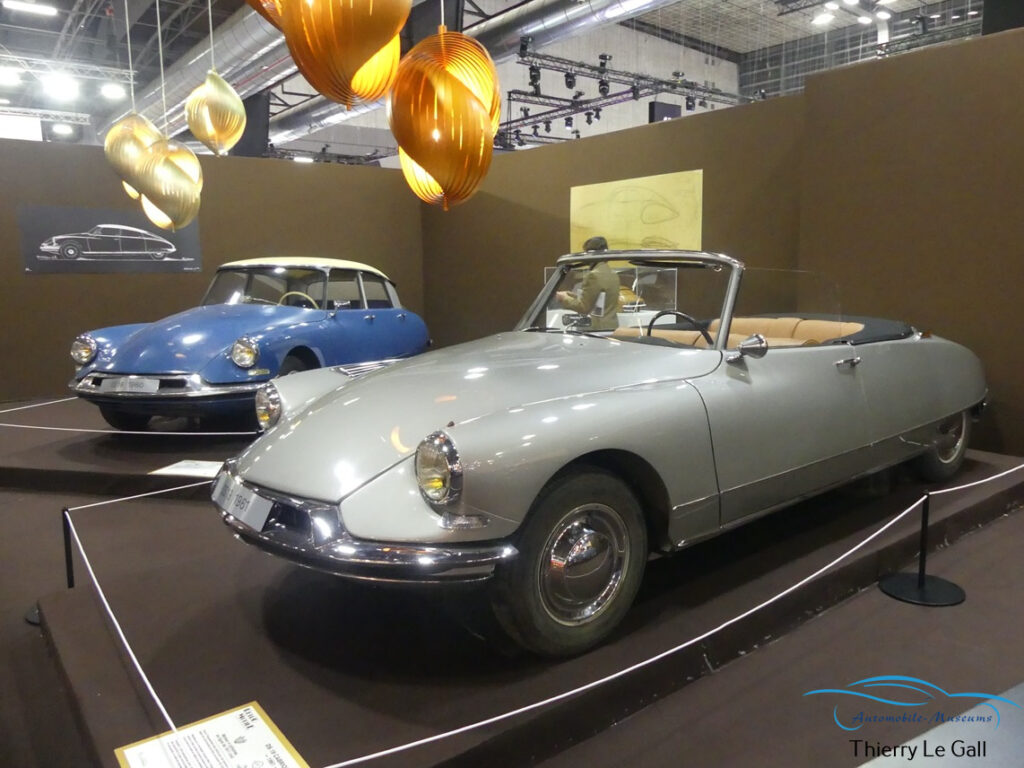
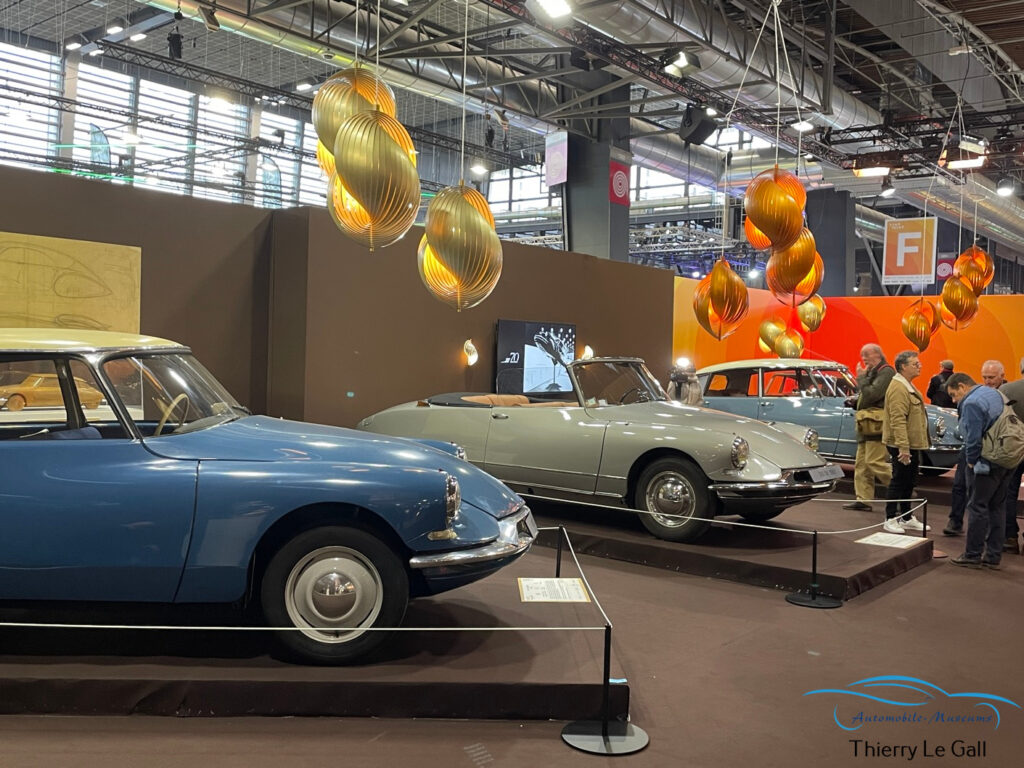
The star of the show is the “DS Balloons” (which illustrated the official poster), faithfully recreated for the occasion. The original had been produced for a 1959 advertisement illustrating the comfort of its hydropneumatic suspension. The 2025 DS Balloons is a 1st-generation DS, stripped of its mechanical components but with its interior, and mounted on 4 balloons. It is installed under lighting by Mathieu lustrerie, Retromobile’s partner for the occasion. Another unique creation, the DS 19 Totem in metallic grey, is a life-size vertical sculpture which was presented at the 1962 Paris Motor Show.



Surrounding these unique works of art are several models from the Citroën Conservatory collection (now closed until a suitable venue can be found for displaying the collection). They represent the relatively minor aesthetic evolutions (a sign that the car was well “born”), apart from the switch to 4 headlamps under glass, 2 of which being directional, and mechanical evolutions from the original 1.9l to the electronically injected 2.3l. One of the models on display is a red DS 21 Pallas, presented without doors (and without engine) at the 1967 Paris Motor Show to promote the new front end with directional lights and the comfort of its interior.





From the ID 19, a simplified entry-level version, to the DS 23 IE, power increased from 66 hp to 141 hp, with a top speed approaching 190 km/h. While this may seem a limited amount of power, it’s worth remembering that at the time, a Porsche 911 only developed 150 hp in its basic version! The Pallas versions brought more luxury and equipment. The black DS 21 Prestige was the “official” car, with its window separating driver and passengers.



The DS also existed as a “factory” convertible, like the 1961 DS 19 presented here. With only 1,325 convertibles produced, it’s obviously one of the most prized DS for collectors. Several drawings and sketches decorate the stand, while a series of sepia-toned posters on the stand’s outer wall recall the history of this world-famous icon.
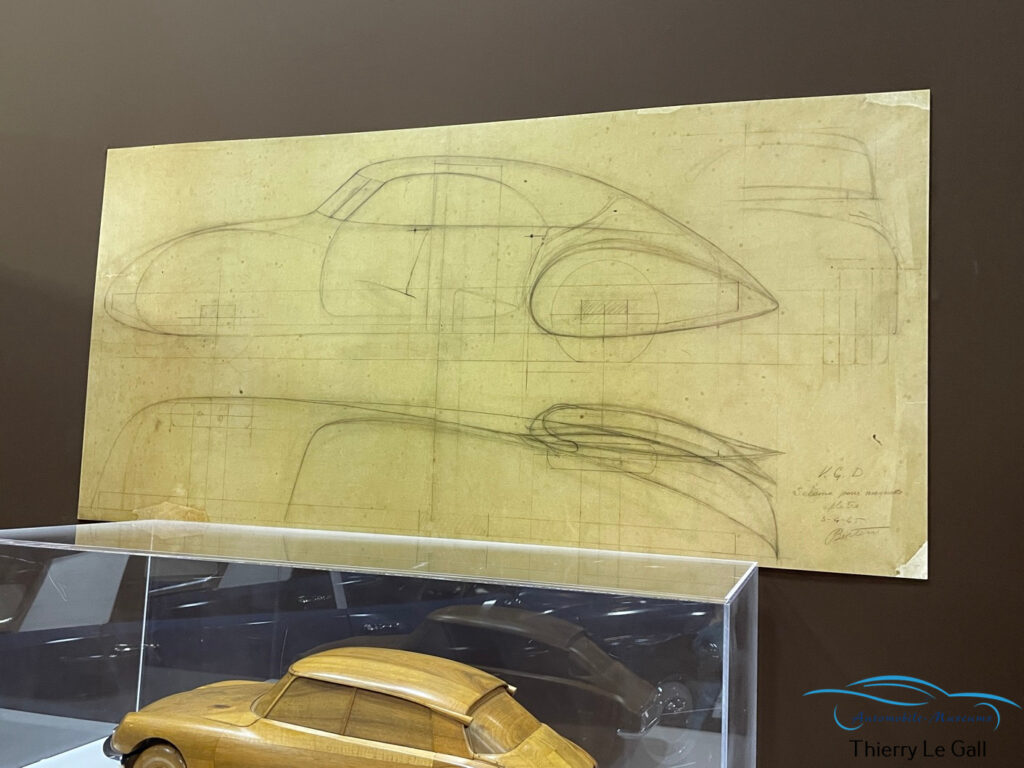
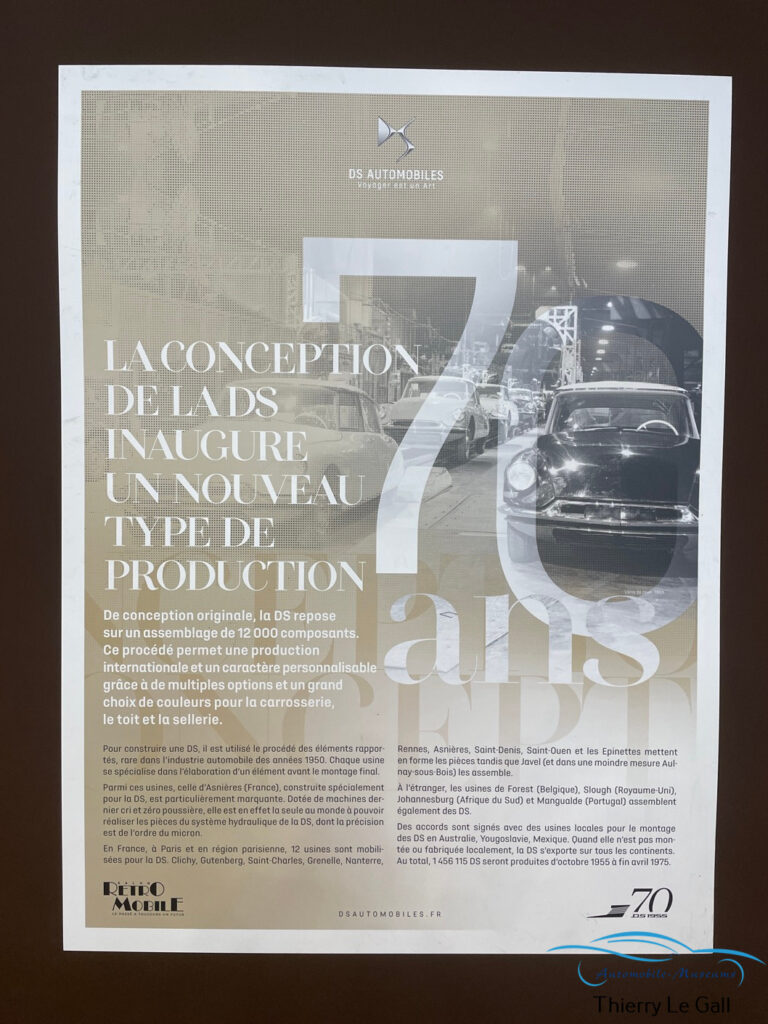
Naturally, Citroën clubs joined in the celebrations, with, for example, a curious DS racing coupe prototype on the Euro SM Club stand – in fact, an SM chassis-engine assembly prepared by the racing department and fitted with a modified DS body.
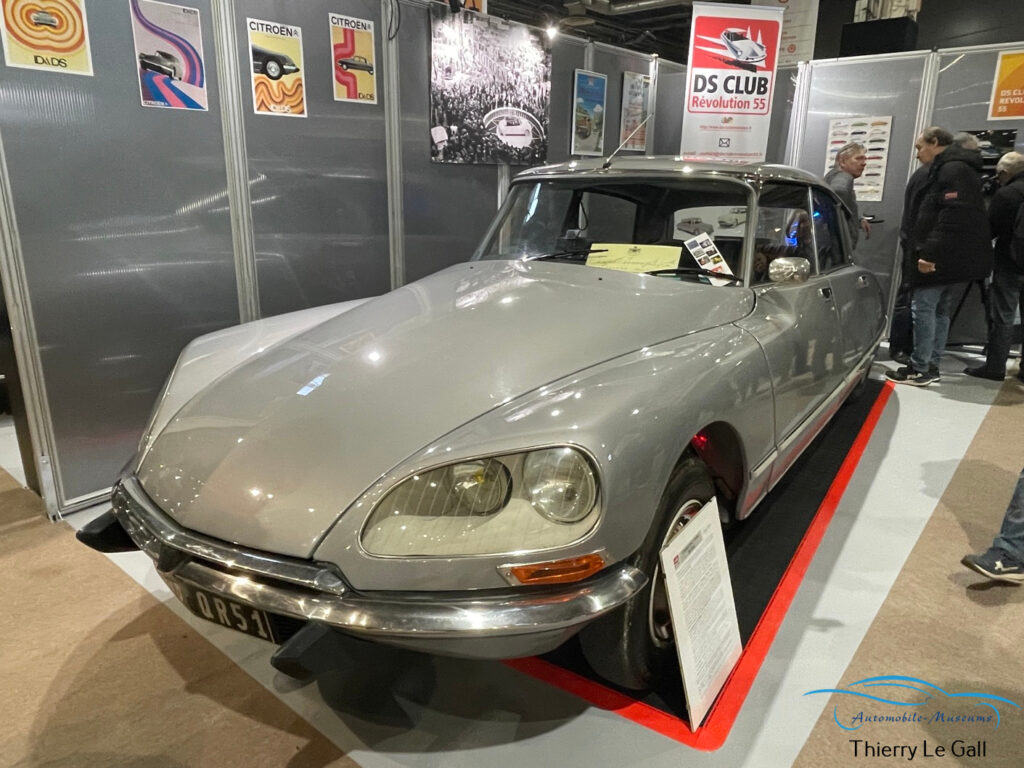
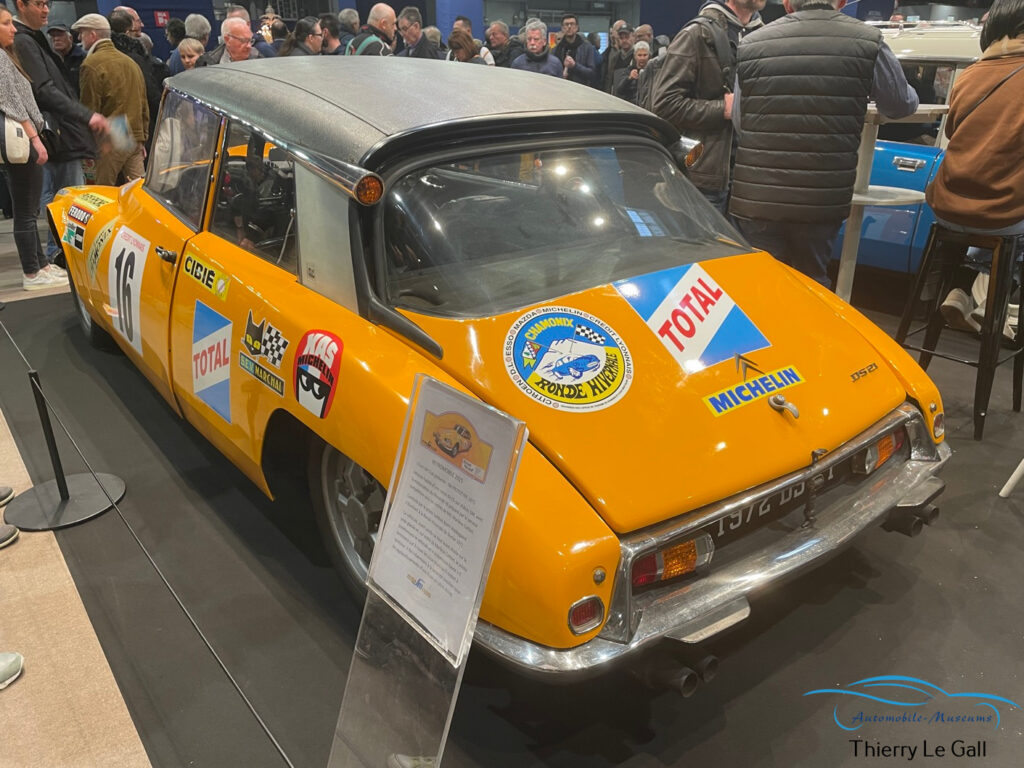
To mark the anniversary, the DS was also in the spotlight on other stands, such as Prevost (official Retromobile transporter) with a handsome DS 21 convertible. At Aguttes, a 1957 DS 19 in its original Daffodil Yellow color announced the Citroën collection offered at the spring sale (one of the novelties with the DS was also the range of colors on offer). Staying in the DS world, the DS Grand Palais Coupe was designed by Gerard Godfroy (designer for Peugeot, Heuliez and Ventury, among others) and built in limited numbers on a DS 21 base. The all-leather interior has been modernized, but the lines remain true to the spirit of the DS.



Adolphe Kegresse Exhibition
The Adolphe Kegresse exhibition keeps us in the Citroën world, and also in the field of innovation. Adolphe Kegresse was the inventor of a particularly efficient track drive system. His meeting with Andre Citroën led to the development of a range of Kegresse models combining a Citroën chassis and possibly bodywork with the Kegresse flexible track system.



These vehicles became famous through Citroën’s famous cruises of the 1920s and 1930s, the Sahara and African Crossings (Black Croisiere) and the Yellow Croisiere (Beirut-Peking). But Citroën Kegresse were also civilian vehicles for difficult terrain, found in the mountains, for hunting or farming. Military versions were also developed, notably to pull artillery pieces, and used by several armies.



The patents were also sold to the US Army, who would produce Half-Tracks on this basis. The Retromobile exhibition featured a dozen vehicles, including civilian models such as the 1923 K1 or the 1931 Torpedo P19, an imposing P20, a unique model bodied as a “hunting station wagon” with a gun rack, and a military P17 version. The 2 Citroën Kegresse “Gold Beetle” and “Silver cCrescent” from the Sahara Crossing are brought together for the first time at this exhibition.




Several models from the Black Croisiere Noire and Yellow Croisiere were presented in a sandy decor, along with the large P19s dedicated to Citroën’s Croisiere cinema and scientific activities.




French Formula 1 Exhibition
The organizers had brought together nearly fifteen Formula 1 single-seaters representing almost 45 years of French F1, from the 1969 Matra MS 80 (world champion with Jackie Stewart) to the 2013 Toro Rosso STR8 (driven by Jean-Eric Vergne). Displayed in a wide arc, under explanatory banners, the cars were either from French manufacturers (Matra, Alpine, Ligier, Renault, Prost), powered by French engines (Renault for the Williams or Peugeot for the Jordan and McLaren), or driven by French drivers (Ferrari, March, Toro Rosso, Williams).




Of course, some F1 cars ticked several or all of these boxes, French chassis, engine and driver, such as the Renault RS 10 (Jean-Pierre Jabouille, 1979), Renault RE 40 (Alain Prost, 1983), Prost AP03 (Jean Alesi, 2000). One single-seater stands out in this very colorful exhibition, the Alpine A500, which was the testing laboratory for the Turbo engine, culminating in the first Renault F1 cars with their 1,500 cc Turbo engine, which in just a few years would completely change the face of Formula 1 and lead to the most powerful F1 cars in history, exceeding 1,000 hp (without electric boost).




The exhibition clearly shows the considerable evolution of aerodynamics in this discipline, from the Matra MS 80’s small flat fins on either side of the snout to the Toro Rosso’s countless fins, deflectors and tie-rods surrounding complex shapes. However, this area wasn’t the only place to admire F1 cars up close and personal.



Keeping with the “France” theme, just a few meters away was another Prost GP on the LRS FORMULA stand (F1 leisure driving), on the Matra stand (which today manufactures electric bicycles) another Matra MS 80 (signed by Jackie Stewart) and a Matra MS 120D, this one with the Matra V12 and which was the last Matra F1 car, a Renault R25 at the FFSA, a 1984 Lotus-Renault 95T on the FIA stand. BRM exhibited the V12-powered P160B with which Jean Pierre Beltoise won the 1972 Monaco GP, and Mitchell Curated the Tyrrell 008 that won the 1978 Monaco Grand Prix with Patrick Depailler.





Back in the days before F1, Bugatti dominated Grand Prix racing with the Type 35C (a 1926 at Lukas-Huni), the 1930 Type 51 (offered by Artcurial) or the 1938 Type 59B for sale at Eberhard Thiesen. Aguttes exhibited a Bugatti-competing 1924 Sunbeam Grand-Prix 2L (offered at its spring sale on March 16). As a reminder of its current McLaren exhibition, the 24 Hours of Le Mans Museum exhibited a 1969 McLaren M9A, one of the rare attempts at a 4-wheel-drive F1 car.




As every year, Richard Mille brought out a few cars from its collection, and this year Ferrari F1 cars were in the spotlight with 8 models, from the F312B (1970 – Jacky Ickx) to the F2007 (Michael Schumacher – 2007), not forgetting the 312 T recognizable by its front spoiler (Clay Regazzoni – 1975). The F1-642 (Alain Prost – 1991) was exhibited without part of its bodywork, showing part of its architecture.





At Sport et Collection, another 312 T, this time from 1980, rubbed shoulders with a Hesketh 308 from 1974, a time when an eccentric (and wealthy) Lord could enter F1 with some success! 3 other F1 cars for sale at the show were a 1976 McLaren M26 (Fiskens), a 2009 Brawn GP (auctioned by Bonhams at the Miami GP 2025), and again at Bonhams, a 2021 Aston Martin Mercedes-AMG, offered without engine and steering wheel.


Manufacturers
More carmakers are exhibiting this year and attracting them is clearly part of the organizers’ development strategy. They sometimes take advantage of an anniversary to showcase their heritage, and one or more recent models in the process. At Mazda, we’re celebrating the 35th anniversary of the MX5, the most mass-produced roadster in the history of the automobile, with over a million units produced. The recipe has remained unchanged since its launch: 2 seats, compact and light, with a small, sparkling engine. There are 4 generations: NA 1989, NB 1997, NC 2005 and ND 2015. The MX 5 is a roadster, but for the NB generation, Mazda also offered a rare coupe (174 units only). The NC is represented by a “Superlight” prototype, a pure roadster with no windscreen.





At Porsche, we’re at another end of the sporting spectrum with the 25th anniversary of the GT3, a very muscular version of the 911, the label referring to a Grand Touring competition classification. The GT3 is aimed at circuit day enthusiasts who still wish to retain a certain road-going versatility. The 1st GT3 (generation 996) was presented in March 1999, and evolved in 2003 into a more powerful phase 2, presented on the Retromobile stand. In 2006, the 997-generation GT3 gained even more power (415 hp) and exceeded 300 km/ (on racetracks and German freeways).






In the 991 generation that followed (yes, Porsche’s generation numbering is not always easy to follow), the GT3 gained even more power (475 hp) and overall performance. In the middle of the stand, the latest-generation 992 phase 2 is even more powerful, with 510 hp. It is presented under a Mathieu chandelier, in a full-option configuration. The evolution of aerodynamics is evident from generation to generation. Porsche also brought along a Carrera 2.8L RSR from 1972, a racing car which to some extent is the origin of the GT3 road cars.
Much less exciting (well, a matter of taste) was Toyota’s focus on electromobility, with the 1st Prius (already almost 40 years old) and the new 100% electric RAV 4. Fortunately, the little Sports 800 roadster from 1965 and the current Yaris WRC put a little gasoline in the mix… Like Toyota, Mitsubishi mixed sport and electricity. On one side 2 Lancer, a 1999 Evolution VI Group A (in fact an identical rebuild) and a 2013 Evolution X road car, on the other the 2001 Dakar-winning Pajero in the hands of Jutta Kleinschmidt (the only woman to have won the Dakar) with a more placid Pajero Mk1 (1986), and in the middle the latest Outlander PHEV.







Skoda has been in existence for 130 years, and took the opportunity to revisit its long history, which began with bicycles at the end of the 19th century, then the first motorcycles at the beginning of the 20th century, under the Laurin & Klement brand, including a CCR racing motorcycle, winner of the 1905 Gordon Bennett Cup. The models presented on the Skoda stand were all original, rare and even unique. These included a 1934 Popular Sport coupé, built in aluminum in 5 examples and now going to be restored by the Skoda Museum, and a cute 1960 Felicia cabriolet, sold mainly for export. The “Ferat” is a unique model, derived from a 1971 Super Sport concept car transformed for the purposes of the 1981 horror film Ferat.









No special celebration at Mercedes, but 2 unique cars. The C 111 concept was based on the 300 SL’s straw-door body. The 1970 Type II was equipped with a 4-piston mid-mounted rotary engine developing 350 hp. Mercedes also exhibited a 600 limousine that once belonged to the famous singer Maria Callas.





Retro wave at Renault, between (more or less) iconic old models and the switch to electric. The original Renault 4 and Renault 5 faced their electric granddaughters, while the R17 contemplated its “restomod” reinterpretation by designer Ora Ïto. In 1926, a specially profiled single-seater Renault 40 CV broke several speed records at Montlhery, including the 24-hour race at an average speed of over 170 km/h (the car on display was an exact replica). Out of reach for the “Filante”, a 100% electric rolling laboratory more or less in the style of its ancestor.





2 “current” Bentley cars: alongside the Continental GT Cabriolet, the British brand presented the Speed Six Continuation, a factory-produced replica of the famous Speed Six, winner of the 1929 and 1930 Le Mans 24 Hours.



Touring is an Italian coachbuilder famous for its “Superleggera” bodies, adopted by Ferrari and Maserati as well as Aston Martin. Today, Touring undertakes complete restorations of vintage models using its construction technique, and was showing 2 Maserati 3500 GT, one completely restored, the other to be completely rebuilt. But Touring has also developed the Veloce 12, based on a Ferrari 550 Maranello, of which some 30 units will be built. A little more power, revised suspension and a more refined interior are on the agenda.





To mark its return to Europe, Cadillac followed the trend from old icons to modern electrics, and took advantage of Retromobile to exhibit its large Lyriq electric SUV alongside a 1958 Eldorado Series 62 Cabriolet, which symbolized all the excessiveness of American cars of that era: huge hood, chrome everywhere, avant-garde equipment…
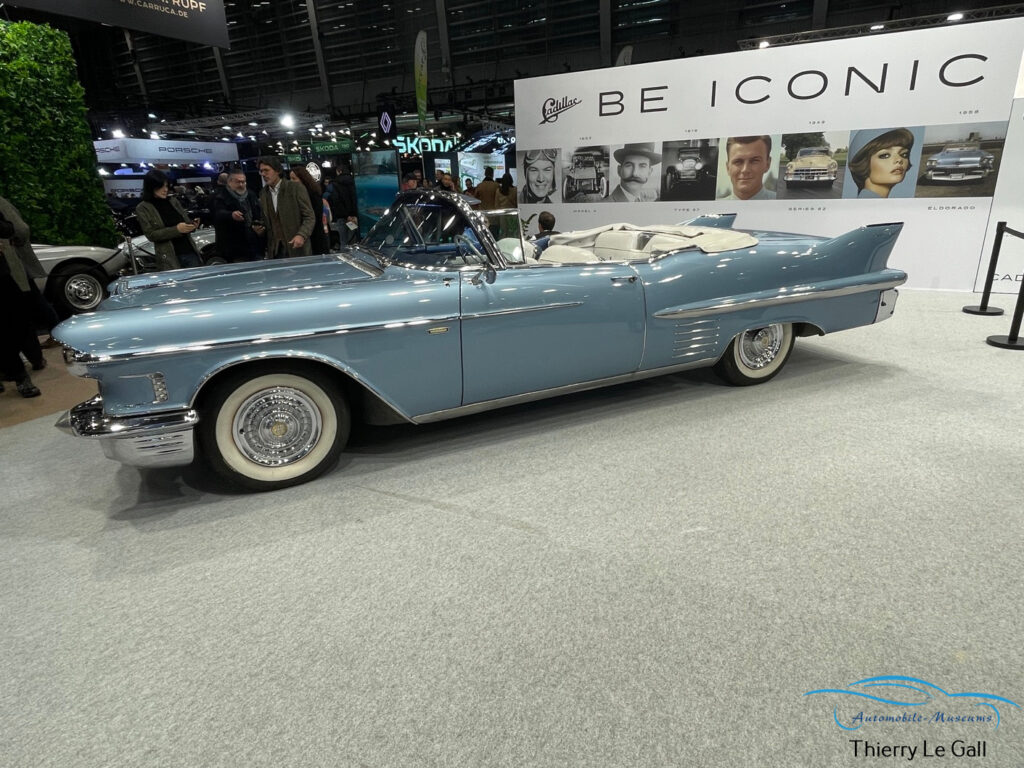
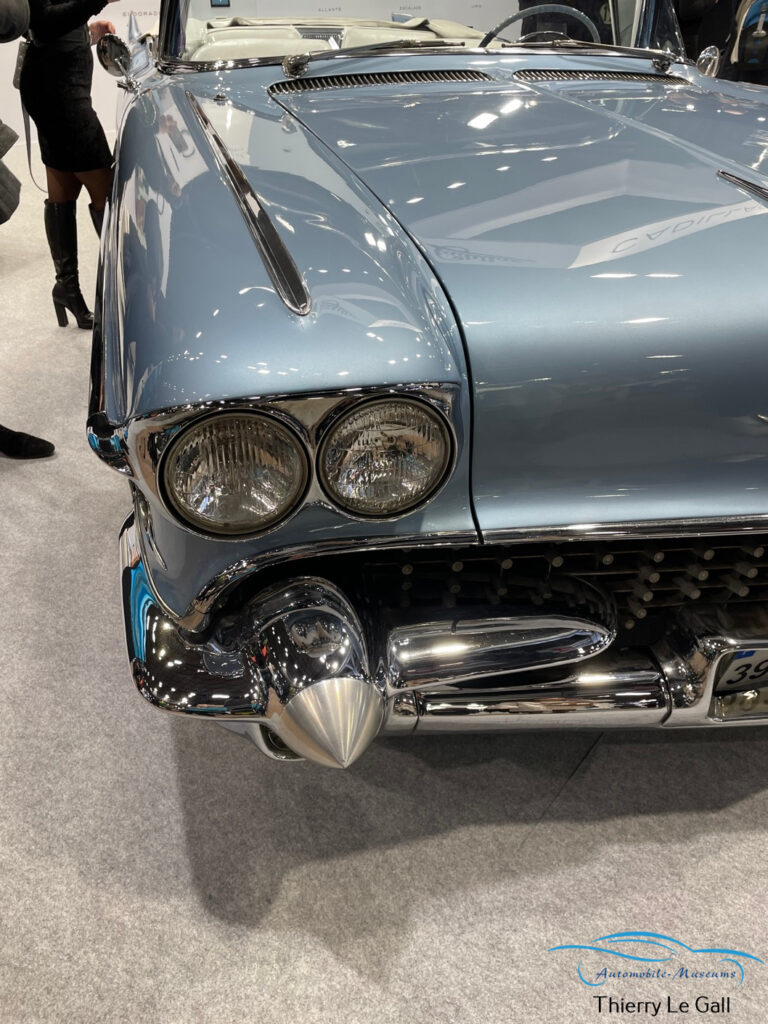
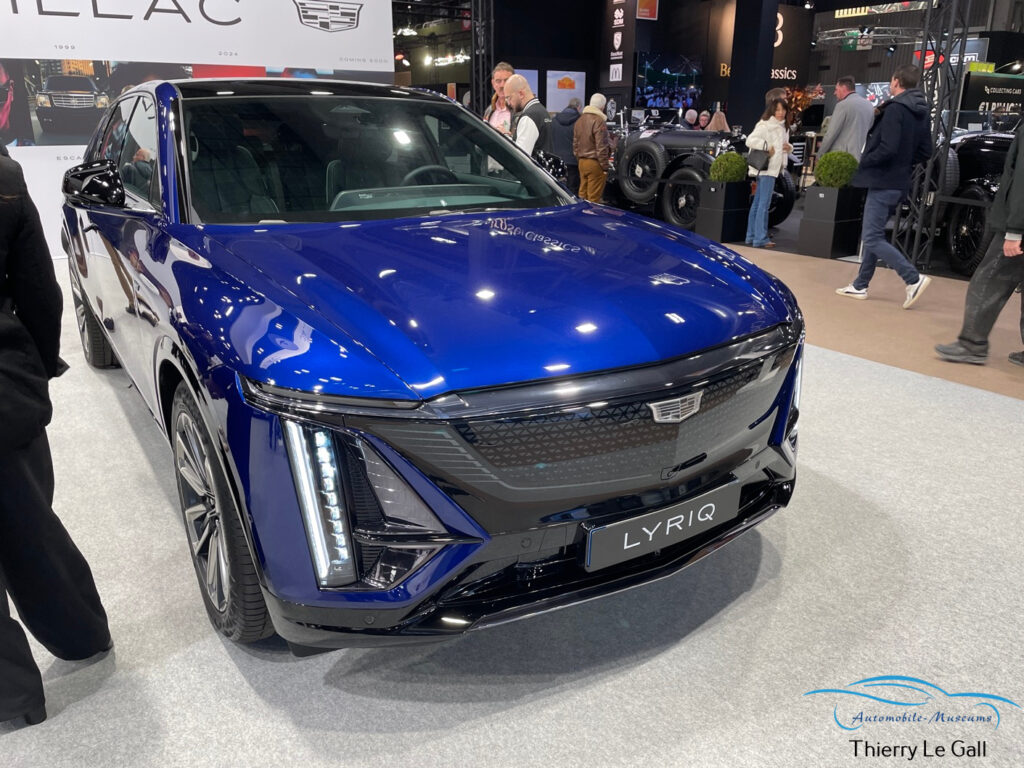
Maserati was represented by its Paris dealer Schumacher and presented an MC 12 Corsa, the supercar that brought Maserati back into competition 20 years ago, alongside 2 current models, the very exclusive MC 20 Stradale and the MC 20 Cielo roadster. The same company also represents Dallara, well known for developing racing cars, and which has launched its own supercar.






Without wishing to be exhaustive, let’s end this overview with 2 slightly different “Restomod” approaches. France’s Hedonic presented its restored, improved and refined Land Rover, while Italy’s Kimera drew inspiration from the legendary Lancia 037 Groupe B world rally champion to develop the EVO 37 and EVO 38, with similar styling but modernized and equipped with state-of-the-art technology.





Museums and institutions
As is the case every year, a number of museums brought to Retromobile a few jewels from their collections. In addition to the McLaren F1 mentioned above, the 24 Hours of Le Mans Museum presented a 1954 Jaguar C-Type, reputed to be the first car equipped with reliable disc brakes, previous attempts having been unsuccessful.



The stand of the French National Automobile Museum in Mulhouse displayed a unique Bugatti, a Type 46 saloon converted into an ambulance for the 2nd World War and preserved in its original condition. Every year, the Gendarmerie Museum showcases a few cars from its fleet, and this year it presented 3 Alpines, the current A110 used for rapid intervention, and 2 older ones, the 1st generation A110 and the A310.




For its 1st presence at Retromobile, in addition to the Lotus 95T, the FIA presented a Mercedes Simplex 28/32 HP from 1904, considered one of the first sports cars in history, and a Rally Citroën Xsara Kit Car. Another major European classic car show, Auto e Moto d’Epoca (Bologna, Italy, October 23-26, 2025) attracted attention with a rare and splendid Alfa Romeo Disco Volante (1952).
Clubs
Car clubs are an essential part of Retromobile, enabling members to get together and exhibit a few emblematic models from their favorite brands. The show had increased the space available to them. Here are just a few examples from among the dozens of clubs present, as I don’t have the space to list them all. Starting with Citroën, La Traction Universelle exhibited a Traction 15 H which was General de Gaulle’s personal car and is still in the family.



Among Peugeot clubs, the prize for rarity undoubtedly went to the 504 Riviera “Shooting Break”. A Pininfarina concept based on the elegant 504 Coupe, this unique model had disappeared and was rebuilt at the request of a British collector. The Facel Vega Club exhibited another unique model, the HK2 prototype that served as the starting point for the Facel II.





Delage reborn, combining a 1930s D8 with the D12 supercar. Other exhibits included the Alfa Romeo Giulia GT and Montreal, Lotus Esprit, Mercedes 190 SL (also 70 years old) and the 1936 Jaguar 1.5L SS, a superb roadster presented by the ever-present French Jaguar Driver’s Club.
Photos on this page belong to Automobile Museums, no reproduction rights without the Owner’s express permission.
